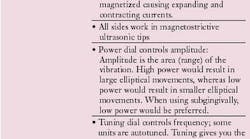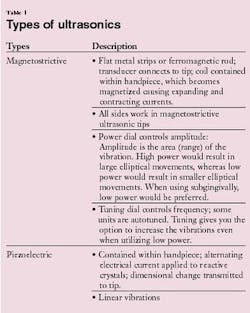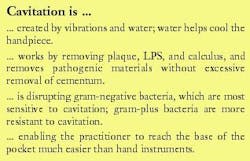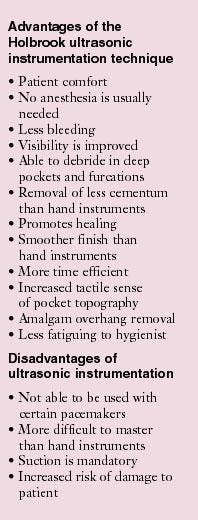by Christine Nathe, RDH, MS
Although ultrasonic instrumentation has been practiced in dental hygiene since the 1950s, a clearer understanding of their effects on the periodontium, new and modified tips, and an improved technique have started a revolution in contemporary dental hygiene practice. Since the inception of dental hygiene, practitioners have been treating periodontal diseases by removing plaque and calculus with hand instruments. Previously, power scalers had been used as an adjunct to hand scaling. Moreover, using the bulkier tips and former technique made complete plaque and calculus removal impossible.
The term "ultrasonic scaling" reflects the use of an ultrasonic instrument to scale the tooth surface, rather than to debride the periodontal areas. Practice has shown that ultrasonic devices used as scalers are not as effective in removing plaque and calculus if pressure is placed on a tooth surface by the operator. The ultrasonic waves and vibrations of the insert and subsequent cavitation cease to function effectively.
Although ultrasonics have been used extensively in dental hygiene treatment, they have not been used to their full potential. Currently, more innovative techniques exist which can be used as the sole method of plaque and calculus removal.
The first modified tip was introduced in the 1960s. Dr. Thomas Holbrook modified his P-10 ultrasonic insert and developed the science and art of debriding the subgingival area exclusively with ultrasonic inserts. Subsequently, an increasing number of favorable reports about ultrasonic instrumentation began to appear in the literature. In fact, by the late 1980s, it was concluded that hand instrumentation and ultrasonic scaling were equally effective. Furthermore, it should be remembered that many of these studies were conducted with traditional ultrasonic inserts used primarily for supragingival and shallow subgingival deposit removal. Research involving the Holbrook technique has the potential to yield more promising results.
Types of ultrasonics and a little about physics ...
Ultrasonic instruments are based on the principles of converting electrical energy into mechanical energy in the form of rapid vibrations. The ultrasonic unit is activated by pressure to the foot pedal, prompting an electrical current to be sent through the generator (the ultrasonic unit) to the handpiece, which holds the transducer (the ultrasonic insert). The transducer then converts the electrical energy to mechanical energy.
Water serves two purposes in ultrasonics. The first purpose is as a cooling agent to control the heat and prevent damage (and pain) to the tooth. The second is that when the insert is vibrating, the water lavage generates a spray. The spray is referred to as cavitation, which plays a major role in plaque and calculus removal.
Although there are numerous brands of ultrasonic units and inserts on the market today, there are two basic types (Table 1). Both types have adjustments for water and power (amplitude), but some magnetostrictive units allow for tuning adjustments via a tuning control.
Amplitude, which is the power of an ultrasonic unit, activates that range or distance of the tip movement during the vibration. Therefore, it is most effective subgingivally to decrease the power so that there is a small vibration that can cause no damage in the sulcus.
The tuning control on an ultrasonic unit controls the number of vibrations or frequency. An increase in tuning would be advantageous in a subgingival area with heavy plaque and calculus accumulation. Many ultrasonic units are autotuned, which leaves the operator no flexibility in determining the tuning setting. However, many newer models do adjust the tuning setting at an increase when a low power setting is chosen.
With these two concepts in mind, it would be recommended in a subgingival area to have the power control in a low setting and the tuning control on a high setting. Therefore, a unit with a manual tuning control is advantageous for the most effective periodontal debridement.
The insert in a magnetostrictive unit is a core that is either a stack of metal strips or a ferromagnetic rod attached to the working end. When the electrical current touches the stack, the rod is magnetized which makes the core contract and when demagnetized the core returns to its original size. When magnetized, the working end vibrates in an elliptical or orbital motion and all sides of the working tip are activated — visualize a spiraling motion. Magnetostrictive units are recommended for both supra and subgingival instrumentation.
The piezoelectric units actually have a crystal transducer. The source of vibration occurs when alternating electrical currents are applied to the crystal transducer creating a dimensional change that is transmitted to the tip in the form of a vibration. Piezoelectric tips move in a linear vibration — visualize a straight back-and-forth motion — and two sides of the working tip are activated. Piezoelectric units are recommended for all instrumentation.
How ultrasonic debridement works
The term "periodontal debridement" has been used to refer to the treatment of periodontal diseases by instrumentation. Quite clearly, it is a more comprehensive title in its reference to treating an infection, as opposed to the term scaling or root planning, which places emphasis on removing calculus from the tooth.
Treating an infection requires elimination or suppression of the infectious microbes, elimination or controlling the source of the infection to prevent re-infection, establishing a biologically acceptable environment to promote health, consideration of host-related factors, and the use of antimicrobial agents as adjuncts to dental hygiene therapy. The considerations most definitely surpass the need to focus solely on removal of calculus.
With the definition of periodontal debridement in mind, it is important to understand the effects of ultrasonic cavitation on the periodontium. Cavitation occurs when water passes over the intense vibrations of the oscillating tip. The rapid formation and destruction of small air cavities occur at maximum vibrating points along the working end. These small air cavities or "cavitation bubbles" implode. When this happens, the implosion releases short bursts of energy. This energy can actually tear apart bacterial cell membranes, killing them.
The lavage helps to remove plaque from hard to reach areas. In fact, one study supported the concept that ultrasonic lavage destroyed plaque far beyond the surfaces actually touched by the tip. The study reported that when water was used with the tip, the activated water removed plaque by 500 percent. This means that the power of the small air cavities make the ultrasonic most effective in hard to reach areas.
Advantages and disadvantages
There are many advantages of subgingival ultrasonic instrumentation. Some of the most pertinent to the dental hygiene practitioner include patient comfort. Because the ultrasonic insert fits nicely within the subgingival area and there is such light pressure on the insert, the patient feels much less discomfort. Local anesthesia is rarely needed when providing ultrasonic instrumentation correctly.
Less bleeding occurs because there is no cutting edge on the insert to damage the soft tissue, either by purposeful curettage or inadvertently. Additionally, the dental hygienist is using an insert that again fits nicely within the subgingival area and this decreases the chance of causing iatrogenic soft tissue laceration and/or trauma. Moreover, the hygienist is not scaling the tooth and is therefore, removing less cementum than hand instruments.
This promotes healing and increases the chance of a smoother finish than achieved with hand instruments. Because there is less bleeding, visibility is greatly improved. Another factor, which helps visibility, is the fact that suction is required which keeps the area dry and easier to see.
Dental hygienists find ultrasonic instrumentation less fatiguing and more time efficient. This will also increase the tactile sense of pocket topography, which increases the effectiveness of deposit removal.
There are few disadvantages to using ultrasonics. The need for suction may be considered a disadvantage. Another could be that proper training is necessary; clinicians untrained in the use of the newer slim inserts and the technique for operation should take a hands-on course to acquire expertise.
Ultrasonic instrumentation is no longer solely used for the gross removal of calculus. In fact, ultrasonic instrumentation has the potential to be the instrument of choice to all dental hygiene practitioners when providing comprehensive dental hygiene care. Compared to hand instrumentation, it offers a more comfortable, efficient and effective method of the treatment for the dental hygienist and patient.
Author's note: The author suggest reading the following chapter written by Kim Herremans, RDH, MS: Hodges, K. Concepts in Nonsurgical Periodontal Therapy. Albany, NY: Delmar Publishers, 1998. Her chapter was utilized as a reference frequently.
Christine Nathe, RDH, MS, is an associate professor and clinic manager at the University of New Mexico Division of Dental Hygiene in Albuquerque. She can be contacted at (505) 272-8147 or cnathe@ salud.unm.edu.
References available upon request









